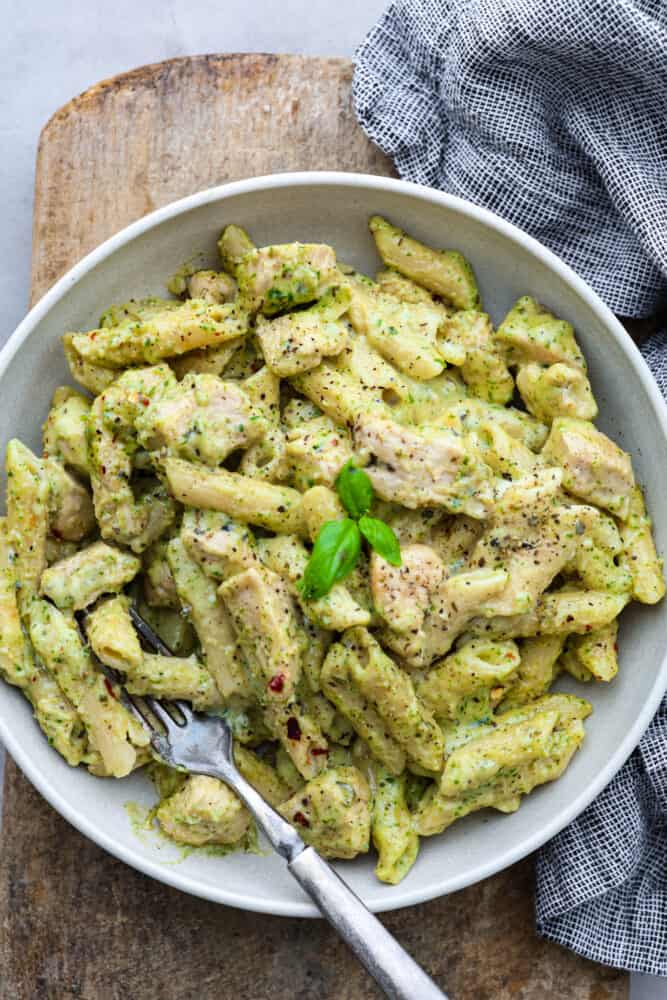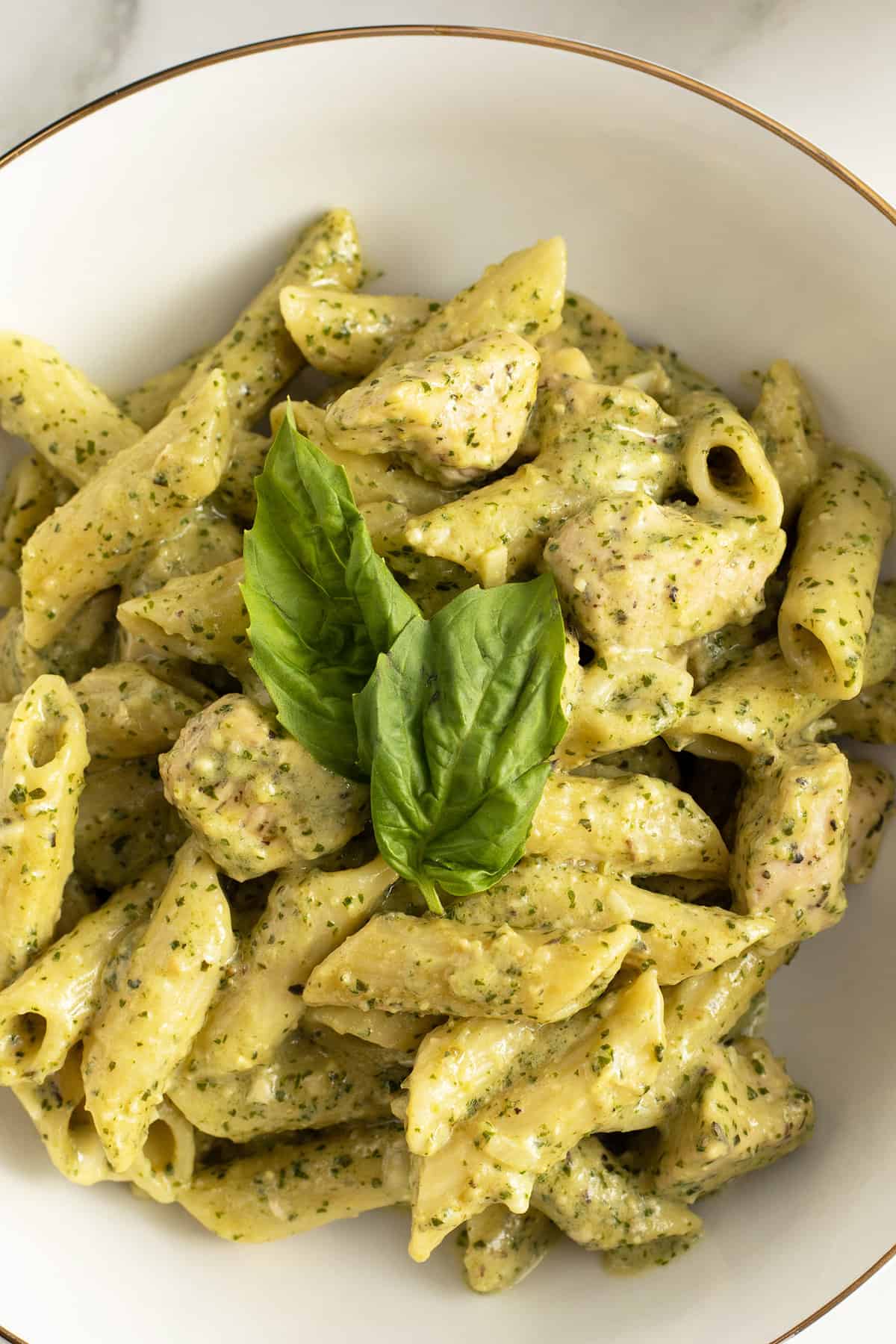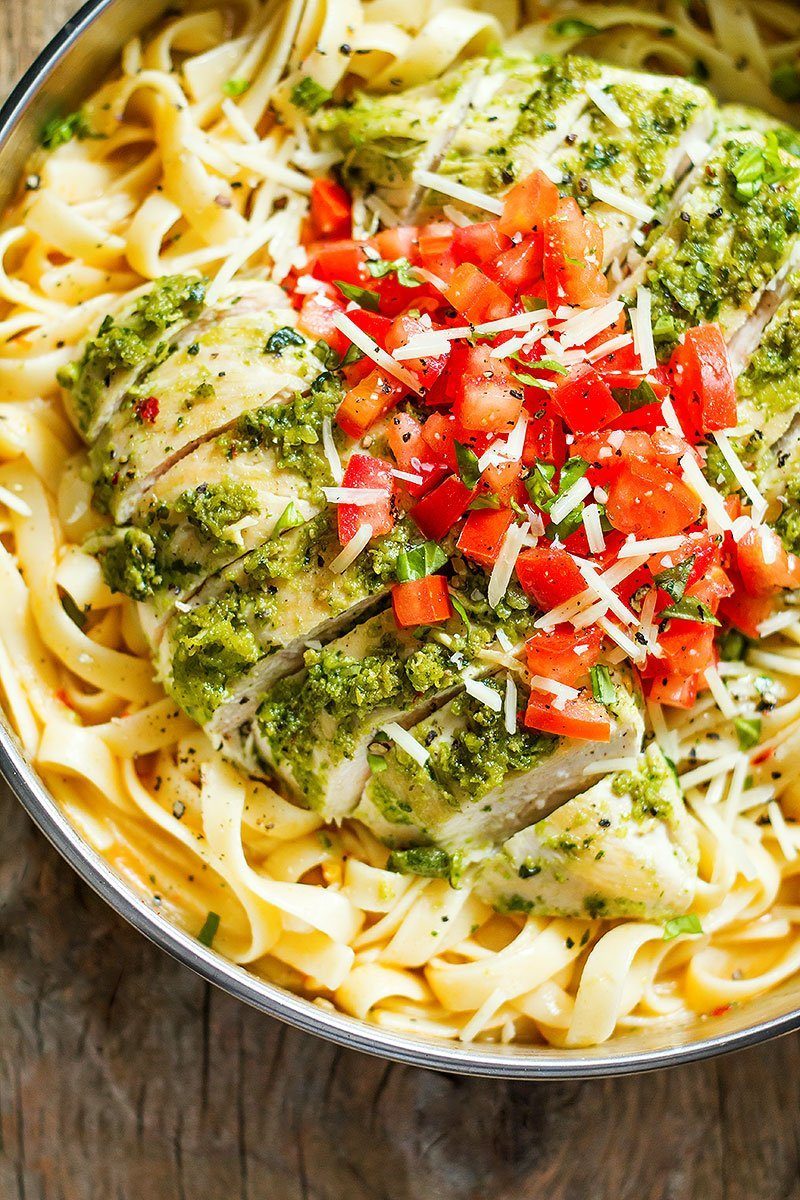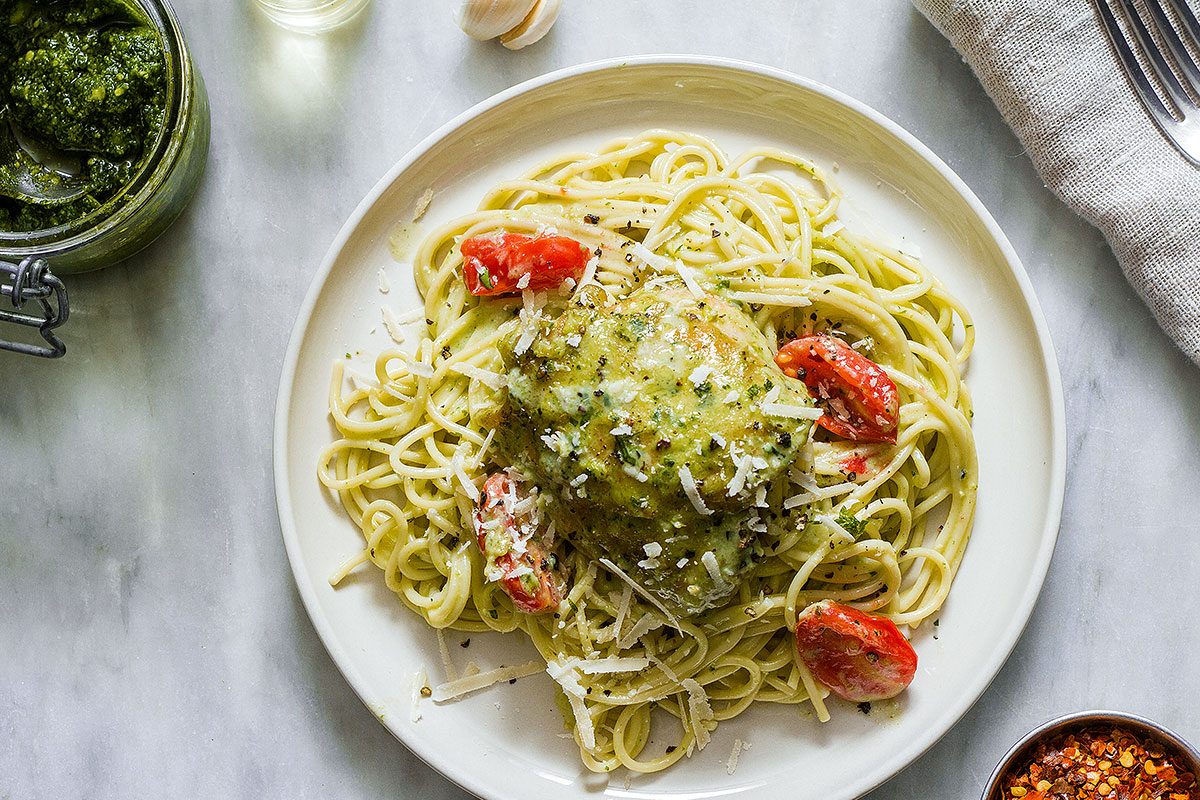Pesto Chicken Pasta: A Symphony of Flavors and Textures

Pesto chicken pasta. The very name conjures images of vibrant green sauce clinging to tender chicken and perfectly cooked pasta, a dish both satisfying and effortlessly elegant. It’s a culinary chameleon, adaptable to various tastes and skill levels, making it a weeknight staple and a crowd-pleaser for special occasions alike. This article will delve deep into the world of pesto chicken pasta, exploring its history, variations, techniques for achieving perfection, and offering creative twists to elevate this classic dish to new heights.
A Brief History: From Ligurian Roots to Global Phenomenon
While the precise origins of pesto are debated, its roots firmly lie in the Ligurian region of Italy, specifically Genoa. The word "pesto" itself derives from the Italian verb "pestare," meaning "to pound," reflecting the traditional method of preparing the sauce using a mortar and pestle. This laborious process, involving the meticulous grinding of basil, garlic, pine nuts, Parmesan cheese, and olive oil, resulted in a vibrant, intensely flavorful sauce that quickly gained popularity throughout Italy and beyond.
The addition of chicken to this classic sauce is a more modern adaptation, a testament to the dish’s adaptability and its ability to incorporate diverse culinary influences. The combination of the herbaceous pesto, the savory chicken, and the comforting pasta creates a harmonious balance of flavors and textures, appealing to a wide range of palates. Its global popularity is a testament to its simplicity, versatility, and undeniable deliciousness.
Mastering the Art of Pesto Chicken Pasta: A Step-by-Step Guide
The beauty of pesto chicken pasta lies in its simplicity. However, achieving truly exceptional results requires attention to detail and a few key techniques. Let’s break down the process step-by-step:
1. The Pesto: The Heart of the Dish
The quality of your pesto directly impacts the overall flavor profile of the dish. While store-bought pesto can be a convenient option, making your own from scratch offers an unparalleled depth of flavor. Here’s a basic recipe:

Ingredients:
- 2 cups fresh basil leaves, packed
- 1/2 cup grated Parmesan cheese
- 1/4 cup pine nuts (or walnuts, for a nuttier flavor)
- 2 cloves garlic
- 1/2 cup extra virgin olive oil
- Salt and freshly ground black pepper to taste

-
Instructions:
- Combine basil, Parmesan, pine nuts, and garlic in a food processor or mortar and pestle.
- Pulse or grind until finely chopped but not completely pureed. Some texture is desirable.
- With the motor running (or while continuously grinding), slowly drizzle in the olive oil until a smooth, creamy consistency is achieved.
- Season with salt and pepper to taste.

2. Preparing the Chicken:
The chicken should be cooked perfectly – juicy and tender, not dry or overcooked. Here are a few options:
- Pan-Seared: Season chicken breasts with salt, pepper, and any desired herbs (rosemary, thyme, or oregano work well). Sear in a hot pan with olive oil until cooked through. Slice into bite-sized pieces.
- Baked: Season chicken breasts as above and bake in a preheated oven at 375°F (190°C) until cooked through. Slice into bite-sized pieces.
- Grilled: Marinate chicken breasts in a mixture of olive oil, lemon juice, garlic, and herbs. Grill until cooked through. Slice into bite-sized pieces.
3. Cooking the Pasta:
Choose a pasta shape that complements the sauce. Penne, rotini, farfalle, or fusilli are all excellent choices. Cook according to package directions until al dente – firm to the bite. Reserve about 1/2 cup of pasta water before draining.
4. Combining the Elements:
Add the cooked pasta to the pan with the chicken. Stir in the pesto, adding a little pasta water if needed to achieve the desired consistency. Toss to coat the pasta evenly. Add more Parmesan cheese if desired.
5. Serving and Garnishing:
Serve immediately, garnished with extra Parmesan cheese, fresh basil leaves, a drizzle of olive oil, or a sprinkle of red pepper flakes for a touch of heat.
Variations and Creative Twists:
The beauty of pesto chicken pasta lies in its adaptability. Here are some creative variations to explore:
- Sun-dried Tomato Pesto: Incorporate sun-dried tomatoes into your pesto for a burst of intense flavor and a vibrant color.
- Spinach and Artichoke Pesto: Add cooked spinach and artichoke hearts to your pesto for a heartier, more complex flavor profile.
- Roasted Red Pepper Pesto: Roast red peppers until soft, then blend them into your pesto for a smoky sweetness.
- Lemon Pesto: Add the zest and juice of a lemon to your pesto for a bright, citrusy twist.
- Spicy Pesto: Add a pinch of red pepper flakes or a dash of your favorite hot sauce to your pesto for a kick.
- Creamy Pesto: Stir in a dollop of cream cheese or heavy cream to your pesto for a richer, creamier sauce.
- Vegetable Additions: Add sauteed vegetables like broccoli, zucchini, mushrooms, or bell peppers for a more nutritious and flavorful dish.
- Different Protein Options: Substitute chicken with shrimp, salmon, tofu, or chickpeas for a vegetarian option.
Tips for Perfection:
- Use fresh, high-quality ingredients: The quality of your ingredients directly impacts the overall flavor of the dish.
- Don’t overcook the pasta: Al dente pasta is key to achieving the perfect texture.
- Adjust the seasoning to your taste: Season generously with salt and pepper throughout the cooking process.
- Add a touch of acidity: A squeeze of lemon juice can brighten the flavors of the dish.
- Don’t be afraid to experiment: Try different variations and find your own perfect pesto chicken pasta recipe.
Beyond the Plate: Pairing and Presentation
Pesto chicken pasta is a versatile dish that pairs well with a variety of beverages and sides. A crisp white wine, such as Pinot Grigio or Sauvignon Blanc, complements the herbaceous notes of the pesto. A light-bodied red wine, like a Pinot Noir, can also work well.
For a complete meal, consider pairing your pesto chicken pasta with a simple side salad dressed with a light vinaigrette or some crusty bread to soak up the delicious sauce. For a more elegant presentation, garnish the dish with fresh basil leaves, grated Parmesan cheese, and a drizzle of olive oil.
Conclusion:
Pesto chicken pasta is more than just a meal; it’s an experience. It’s a testament to the power of simple ingredients combined in perfect harmony. With its versatility, adaptability, and undeniable deliciousness, it’s a dish that deserves a place in every cook’s repertoire. So, gather your ingredients, embrace the process, and embark on a culinary journey that will leave you satisfied and craving more. Experiment, innovate, and discover your own perfect version of this timeless classic. The possibilities are as endless as your imagination.

Video tentang Pesto Chicken Pasta: A Symphony of Flavors and Textures
Penutup
Therefore, we hope this article has provided valuable insights on Pesto Chicken Pasta: A Symphony of Flavors and Textures. We hope you found this article informative and helpful. See you in our next article!

